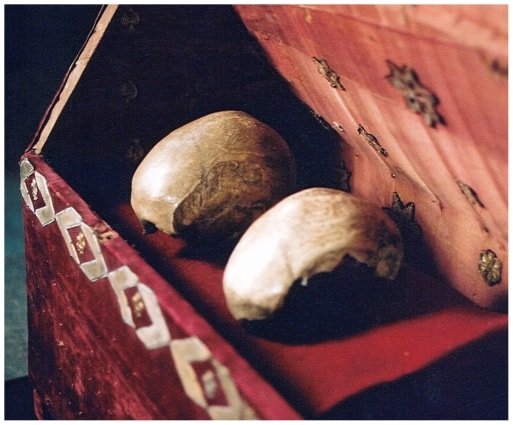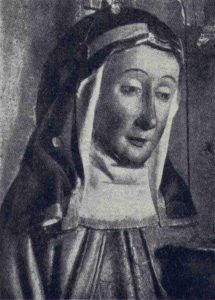First story

Whose skulls are they, then? Were the actual skulls stolen?
We’ll let the archeologists and geneticists haggle over that. What we’re interested in is the fact that St. Bridget was a great prophet as well as a great saint. The news about her reminded us of her many prophecies, some of which — if valid — may be relevant to our own time. We have to emphasize that while she was canonized and her visions received Church approval, authorities have said that such meant her messages didn’t contain anything contrary to the faith and was not an actual validation of her predictions.
The daughter of a Swedish governor, St. Bridget was seven when she had a vision in which she was crowned by the Blessed Mother. The visions would continue her whole life, highlighted by reputed appearances of Jesus. “Bridget’s father consecrated all Fridays to special acts of penance, and from her childhood St. Bridget loved to meditate upon the Passion of Christ,” notes a website. “In obedience to her father, at the age of 13 she married Ulfo, Prince of Nericia in Sweden, by whom she had eight children, the last of whom, Catherine, is now honored among the Saints. Later the couple made a pilgrimage to Compostela in Galicia. On their return to Sweden, Ulfo, was stricken with an attack of illness, but recovered sufficiently to finish the journey. Shortly afterwards, however, he died (1344) in the Cistercian monastery of Alvastra in East Gothland. After his death St. Bridget founded a new religious congregation, the Brigittines, or Order of St. Savior.”
The saint lived during a period when the Church was in disarray and when the world was about to be hit by a great chastisement called the bubonic plague, all of which affected and troubled her greatly. We know from Butler’s Lives of the Saints that a number of her prophecies — often focusing on current affairs — materialized. She prophesied that the Pope Urban V and Emperor Charles IV would meet amicably in Rome — which indeed happened in 1368 — and later forewarned the Pope that he was approaching death (which occurred four months hence).

We have been searching to see if there is any truth to some more dramatic prophecies attributed to her. According to one account, St. Bridget prophesied that “when the Feast of St. Mark shall fall on Easter, the Feast of St. Anthony on Pentecost, and that of St. John on Corpus Christi, the whole world shall cry, ‘Woe!’
“The time of Antichrist will be near when the measure of in justice will overflow and when wickedness has grown to immense proportions, when the Christians love heresies and the unjust trample underfoot the servants of God.
“At the end of this age, the Antichrist will be born. As Christ was born from the highest type of womanhood so Antichrist will be born from the lowest. He will be a child-wonder at birth. His mother will be an accursed woman, who will pretend to be well-informed in spiritual things, and his father will be an accursed man, from the seed of whom the devil shall form his work.
“The time of this Antichrist, well-known to me, will come when iniquity and impiety shall above measure abound, when injustice shall have filled the measure to overflowing, and wickedness shall have grown to immeasurable proportions…. He will reign during three years, and shall have dominion over the whole earth…. “
Alleged Prophecy Of St. Bridget: Does It Indicate Year Of Apocalyptic Events?
By Michael H. Brown
Second story
We noted quite some interest stirred by an article (above) we ran on the alleged prophecies of St. Bridget of Sweden. According to one account, this saint prophesied that “when the Feast of St. Mark shall fall on Easter, the Feast of St. Anthony on Pentecost, and that of St. John on Corpus Christi, the whole world shall cry, ‘Woe!'” — going on to describe the time when apocalyptic events would begin.
We don’t know what to think of this prophecy, and as we stated, we can’t even confirm that it’s from St. Bridget. It is interesting that some cite the date of June 24 (which is also the date of the first apparition in Medjugorje) and the year 2038. Our book, The Final Hour speculates that the secrets of Medjugorje will unfold by 2040 (with events also occurring before then, of course, as a graduation of events intensifies).
But back to St. Bridget: what to think of it? We heard from some readers:
“Some of us may have already ‘done the math’ and figured out that perhaps 2004 is when that next will occur, since April 25 (St. Mark’s Feast Day) falls on a Sunday, and may be Easter Sunday,” writes a correspondent named Kathy. “But I’m not sure if Easter falls on that Sunday in 2004..? Either way, to get all those dates in her prophecy to align, as long as Easter Sunday falls on Sunday April 25 , then all those other dates and feast days will fall into place after it. I have a calendar tool, and saw that in the next 100 years, St. Mark’s feast day will be Sunday April 25 (and perhaps also be Easter Sunday) in: 2010, 2021, 2027, 2032, 2038, 2049, 2055, 2060, 2066, 2077, 2083, 2088, 2094, 2100.”
Says Dibby Green of Santa Barbara, California: “I had to see how complicated it was to have Feast of St. Mark fall on Easter, Feast of St. Anthony (of Padua) fall on Pentecost, and Feast of St. John (birth of John the Baptist) fall on Corpus Christi.
Pentecost is 49 days after Easter
Corpus Christi is 60 days after Easter, or 11 days after Pentecost.
St. Mark feast day = April 25
St. Anthony feast day = June 13, which is 49 days later
St. John the Baptist birthday = June 24, which is 11 days later, or 60 days
after Easter.
Therefore, any year that Easter falls on April 25th, the remaining dates
will fall in line.
Gregorian Calendar is on a 400-year cycle; Easter is on a 5,700,000-year
cycle. Between 1875 and 2124, Easter falls on April 25th in 1886, 1943, and
2038, and coincidentally Easter is April 25th in those three years for both
Orthodox Easter under the Gregorian Calendar and for the Western Church
calendar under the Gregorian Calendar. (Under the Orthodox Julian Calendar,
Easter falls on 4/25 in 1983 and 2078.) (I could not locate historical
Easter dates before 1875, or calculations after 2124.) So the only occurrence between now and 2124 is in 2038.”
Added a correspondent named Doris Ballard: “First off, before 1970, Corpus Christi was celebrated on the Thursday after Trinity Sunday. St. Mark’s Feast is on April 25
St. Anthony’s Feast is on June 13. St. John the Baptist is on June 24. Since St. Bridget’s birth, Easter has fallen on April 25 in 1451, 1546, 1666, 1734, 1886, and 1943, and will do so again in 2038 and 2190. The other two dates, of course, fall in line behind it.”
[resources: Michael Brown retreat, Chicago, and Where the Cross Stands]

